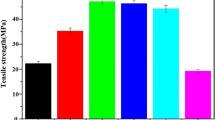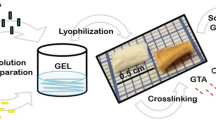Abstract
In this work, carboxylated bamboo fiber (BF) was first incorporated into nano-hydroxyapatite/chitosan (n-HA/CS) system to obtain a novel porous composite by freeze-drying method for bone tissue engineering scaffold. The results of infrared spectrometer analysis, scanning electron microscope observation, porosity and compressive strength test revealed that the ionic-crosslinking of carboxylated BF and CS played an important role in the formation of the composite scaffold with a highly orientation groove porous structure. Especially, when 30 wt% carboxylated BF was added, the compressive strength of n-HA/CS composite scaffold was enhanced up to over three times, and the porosity was still higher than 80%. Moreover, simulated body fluids soaking demonstrated that the introduction of carboxylated BF not only slowed down the degradation of n-HA/CS composite scaffold by the ionic-crosslinking, but also induced more apatite to deposit owing to the exposure of excessive carboxyl of carboxylated BF. Additionally, in vitro cell culture results indicated that the introduction of BF were helpful for cell compatibility. Conclusively, carboxylated BF endowed the scaffold with a highly interconnected orientation porous structure, excellent compressive strength, appropriate degradation and good biocompatibility, which would provide a new way for realizing high value-added applications of BF as a low-cost biomass resource.
Graphical abstract
In this manuscript, carboxylated bamboo (BF) was introduced to n-HA/chitosan (n-HA/CS) system, and the effect of carboxylated BF on the n-HA/CS composite scaffold was investigated. The results revealed that the carboxylated BF/n-HA/CS composite scaffold with high orientation groove porous structure could be obtained by freeze drying method, owing to the strong ionic cross-linking between carboxylated BF and CS, which endowed the novel modified BF/n-HA/CS composite scaffold with high mechanical properties, more suitable degradation and better bioactivity and biocompatibility. The study would offer a way of exploring the new application of natural BF in bone tissue engineering scaffold.










Similar content being viewed by others
Data availability
The raw data supporting the conclusion of this article will be made available by the authors, without undue reservation.
References
Aswathy SH, Mohan CC, Unnikrishnan PS, Krishnan AG, Nair MB (2021) Decellularization and oxidation process of bamboo stem enhance biodegradation and osteogenic differentiation. Mat Sci Eng C-Mater 119:111500
Bharathi R, Ganesh SS, Harini G, Vatsala K, Anushikaa R, Aravind S, Abinaya S, Selvamurugan N (2022) Chitosan-based scaffolds as drug delivery systems in bone tissue engineering. Int J Biol Macromol 222:132–153
Bhat S, Uthappa UT, Altalhi T, Jung HY, Kurkuri MD (2022) Functionalized porous hydroxyapatite scaffolds for tissue engineering applications: a focused review. ACS Biomater-Sci Eng 8:4039–4076
Daskalova A, Ostrowska B, Zhelyazkova A, Swieszkowski W, Trifonov A, Declercq H, Nathala C, Szlazak K, Lojkowski M, Husinsky W, Buchvarov I (2018) Improving osteoblasts cells proliferation via femtosecond laser surface modification of 3D-printed poly-epsilon-caprolactone scaffolds for bone tissue engineering applications. Appl Phys A-Mater 124:213
Ding HJ, Jiang LY, Tang CY, Tang S, Ma BL, Zhang N, Wen Y, Zhang Y, Sheng LP, Hu X (2021) Study on the surface-modification of nano-hydroxyapatite with lignin and corresponding nanocomposite with poly (lactide-co-glycolide). Front Chem Sci Eng 15:630–642
Duan PZ, Shen J, Zou GH, Xia X, Jin B (2018) Biomimetic mineralization and cytocompatibility of nanorod hydroxyapatite/graphene oxide composites. Front Chem Sci Eng 12:798–805
Gendviliene I, Simoliunas E, Rekstyte S, Malinauskas M, Zaleckas L, Jegelevicius D, Bukelskiene V, Rutkunas V (2020) Assessment of the morphology and dimensional accuracy of 3D printed PLA and PLA/Hap-scaffolds. J Mech Behav Biomed 104:103616
Guan QQ, Chen JJ, Chen D, Chai XS, He L, Peng LC, Zhang JH, Li J (2019) A new sight on the catalytic oxidation kinetic behaviors of bamboo cellulose fibers under TEMPO-oxidized system: the fate of carboxyl groups in treated pulps. J Catal 370:304–309
Hu M, Wang CH, Lu C, Anuar NIS, Yousfani SHS, Jing ML, Chen Z, Zakaria S, Zuo HF (2020) Investigation on the classified extraction of the bamboo fiber and its properties. J Nat Fibers 17:1798–1808
Ielo I, Calabrese G, De Luca G, Conoci S (2022) Recent Advances in hydroxyapatite-based biocomposites for bone tissue regeneration in orthopedics. Int J Mol Sci 23:9721
Jiang LY, Jiang ZH, Ma BL, Ma YJ, Wen Y, Zhang N, Zhang Y, Su SP, Tang XG, Hu X (2022) Effect of different preparation conditions on the properties of nano-hydroxyapatite/bamboo fiber composite membrane. Cellulose 29:9361–9374
Jiang LY, Li Y, Ma BL, Ding HJ, Su SP, Xiong CD (2018) Effect of bamboo fiber length on mechanical properties, crystallization behavior, and in vitro degradation of bamboo fiber/nanohydroxyapatite/poly(lactic-co-glycolic) composite. Ind Eng Chem Res 57:4585–4591
Jiang LY, Li YB, Wang XJ, Zhang L, Wen JQ, Gong M (2008) Preparation and properties of nano-hydroxyapatite/chitosan/carboxymethy cellulose composite scaffold. Carbohydr Polym 74:680–684
Jiang LY, Li Y, Xiong CD, Su SP, Ding HJ (2017a) Preparation and properties of bamboo fiber/nano-hydroxyapatite/poly(lactic-co-glycolic) composite scaffold for bone tissue engineering. ACS Appl Mater Inter 9:4890–4897
Jiang LY, Li Y, Xiong CD, Su SP (2017b) Preparation and characterization of a novel degradable nano-hydroxyapatite/poly(lactic-co-glycolic) composite reinforced with bamboo fiber. Mater Sci Eng C-Mater 75:1014–1018
Jiang LY, Ma BL, Li Y, Ding HJ, Su SP, Xiong CD (2019) Effect of bamboo fiber on the degradation behavior and in vitro cytocompatibility of the nano-hydroxyapatite/poly (lactide-co-glycolide) (n-HA/PLGA) composite. Cellulose 26:1099–1110
Kim H, Hwangbo HJ, Koo YW, Kim GH (2020) Fabrication of mechanically reinforced gelatin/hydroxyapatite bio-composite scaffolds by core/shell nozzle printing for bone tissue engineering. Int J Mol Sci 21:3401
Kumar R, Mohanty S (2022) Hydroxyapatite: a versatile bioceramic for tissue engineering application. J Inorg Organomet Polym. https://doi.org/10.1007/s10904-022-02454-2
Lee SS, Du XY, Kim I, Ferguson SJ (2022) Scaffolds for bone-tissue engineering. Matter-US 5:2722–2759
Li Y, Jiang LY, Xiong CD, Peng WJ (2015) Effect of different surface treatment for bamboo fiber on the crystallization behavior and mechanical property of bamboo fiber/nanohydroxyapatite/poly(lactic-co-glycolic) composite. Ind Eng Chem Res 54:12017–12024
Lin MY, Zou Q, Wang CX, Zhang R, Li YF, Li TH, Li YB (2022) A new strategy to prepare n-HA/CS composite scaffolds with surface loading of CS microspheres. Int J Polym Mater 71:1199–1209
Long HB, Wu ZQ, Dong QQ, Shen YT, Zhou WY, Luo Y, Zhang CQ, Dong XM (2019) Effect of polyethylene glycol on mechanical properties of bamboo fiber-reinforced polylactic acid composites. J Appl Polym Sci 136:47709
Ma BL, Jiang LY, Tang CY, Tang S, Su SP, Shu Y (2020) Preparation and properties of biomimetic hydroxyapatite-based nanocomposite utilizing bamboo fiber. Cellulose 27:2069–2083
Pappu A, Pickering KL, Thakur VK (2019) Manufacturing and characterization of sustainable hybrid composites using sisal and hemp fibres as reinforcement of poly (lactic acid) via injection moulding. Ind Crops Prod 137:260–269
Rahman S, Maria KH, Ishtiaque MS, Nahar A, Das H, Hoque SM (2020) Evaluation of a novel nanocrystalline hydroxyapatite powder and a solid hydroxyapatite/Chitosan-Gelatin bioceramic for scaffold preparation used as a bone substitute material. Turk J Chem 44:884–900
Rasheed M, Jawaid M, Parveez B (2021) Preparation, characterization and properties of biodegradable composites from bamboo fibers-mechanical and morphological study. J Polym Environ 29:4120–4126
Ressler A (2022) Chitosan-based biomaterials for bone tissue engineering applications: a short review. Polymers 14:3430
Roseti L, Parisi V, Petretta M, Cavallo C, Desando G, Bartolotti I, Bartolotti I, Grigolo B (2017) Scaffolds for bone tissue engineering: state of the art and new perspectives. Mater Sci Eng C-Mater 78:1246–1262
Salifu AA, Lekakou C, Labeed FH (2017) Electrospun oriented gelatin-hydroxyapatite fiber scaffolds for bone tissue engineering. J Biomed Mater Res A 105:1911–1926
Sangkert S, Kamolmatyakul S, Meesane J (2020) The bone-mimicking effect of calcium phosphate on composite chitosan scaffolds in maxillofacial bone tissue engineering. J Appl Biomater Funct 18:2280800019893204
Sanjay MR, Siengchin S, Parameswaranpillai J, Jawaid M, Pruncu CI, Khan A (2019) A comprehensive review of techniques for natural fibers as reinforcement in composites: preparation, processing and characterization. Carbohydr Polym 207:108–121
Sokolova V, Kostka K, Shalumon KT, Prymak O, Chen JP, Epple M (2020) Synthesis and characterization of PLGA/HAP scaffolds with DNA-functionalised calcium phosphate nanoparticles for bone tissue engineering. J Mater Sci-Mater Med 31:102
Tang S, Jiang LY, Ma BL, Tang CY, Wen Y, Zhang N, Zhang Y, Su SP (2020) Preparation and characterization of bamboo fiber/chitosan/nano-hydroxyapatite composite membrane by ionic crosslinking. Cellulose 27:5089–5100
Tallia F, Ting HK, Page SJ, Clark JP, Li SW, Sang T, Russo L, Stevens MM, Hanna JV, Jones JR (2022) Improving the in vitro degradation, mechanical and biological properties of AZ91-3Ca Mg alloy via hydrothermal calcium phosphate coatings. Front Mater 9:901196
Vafa E, Bazargan-Lari R, Bahrololoom ME, Amani AM (2022) Effect of Polyvinyl alcohol concentration on biomedical application of chitosan/bioactive glass composite coated on AZ91D magnesium alloy. Mater Chem Phys 291:126650
Vafa E, Bazargan-Lari R, Bahrololoom ME (2021) Electrophoretic deposition of polyvinyl alcohol/ natural chitosan/ bioactive glass composite coatings on 316L stainless steel for biomedical application. Prog Org Coat 151:106059
Xiang WY, Li SB, Li K, Li N (2016) Preparation of bamboo fibers adsorbent modified by citric acid. Chin J Environ Eng 10:5542–5548
Xu LJ, Jiang LY, Xiong CD, Jiang LX (2014) Effect of different synthesis conditions on the microstructure, crystallinity and solubility of Mg-substituted hydroxyapatite nanopowder. Adv Powder Technol 25:1142–1146
Xue NN, Ding XF, Huang RZ, Jiang RH, Huang HY, Pan X, Min W, Chen J, Duan JA, Liu P, Wang YW (2022) Bone tissue engineering in the treatment of bone defects. Pharmaceuticals-Base 15:1023
Ying RL, Wang HC, Sun RX, Chen KZ (2020) Preparation and properties of a highly dispersed nano-hydroxyapatite colloid used as a reinforcing filler for chitosan. Mater Sci Eng C-Mater 110:110689
Zia I, Jolly R, Mirza S, Rehman A, Shakir M (2022) Nanocomposite materials developed from nano-hydroxyapatite impregnated chitosan/kappa-carrageenan for bone tissue engineering. ChemistrySelect 7:e202103234
Zhang N, Zhang HH, Li R, Xing YJ (2020) Preparation and adsorption properties of citrate-crosslinked chitosan salt microspheres by microwave assisted method. Int J Biol Macromol 152:1146–1156
Zhao Y, Zhao SN, Ma ZX, Ding CM, Chen JD, Li JS (2022) Chitosan-based scaffolds for facilitated endogenous bone re-generation. Pharmaceuticals-Base 15:1023
Zhou Y, Liu XY, She HJ, Wang R, Bai F, Xiang BY (2022) A silk fibroin/chitosan/nanohydroxyapatite biomimetic bone scaffold combined with autologous concentrated growth factor promotes the proliferation and osteogenic differentiation of BMSCs and repair of critical bone defects. Regen Ther 21:307–321
Acknowledgments
The authors thank School Life Science, Hunan Normal University to provide the support of cell culture experiment.
Funding
The authors declare that no funds, grants, or other support were received during the preparation of this manuscript.
Author information
Authors and Affiliations
Contributions
S.T. is the lead author having conducting a great deal of the experiments and data analysis, and he wrote the first draft of the paper. L.J. contributed to the design of research and revising of the manuscript. Z.J., Y.M., Y.Z. and S.S. extensively edited and revised the manuscript.
Corresponding authors
Ethics declarations
Competing interests
The authors declare that they have no competing interests.
Consent for publication
All authors gave their consent for publication.
Ethical approval
The experimental protocol was approved by the Human Ethics Committee of Hunan Normal University.
Additional information
Publisher's Note
Springer Nature remains neutral with regard to jurisdictional claims in published maps and institutional affiliations.
Rights and permissions
Springer Nature or its licensor (e.g. a society or other partner) holds exclusive rights to this article under a publishing agreement with the author(s) or other rightsholder(s); author self-archiving of the accepted manuscript version of this article is solely governed by the terms of such publishing agreement and applicable law.
About this article
Cite this article
Tang, S., Jiang, L., Jiang, Z. et al. Improving the mechanical, degradation properties and biocompatibility of nano-hydroxyapatite/chitosan composite scaffold by the introduction of carboxylated bamboo fiber. Cellulose 30, 1585–1597 (2023). https://doi.org/10.1007/s10570-022-05001-x
Received:
Accepted:
Published:
Issue Date:
DOI: https://doi.org/10.1007/s10570-022-05001-x




